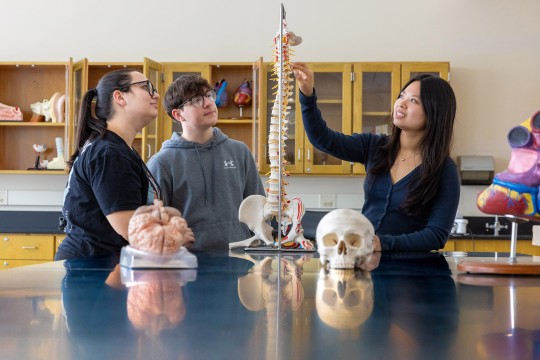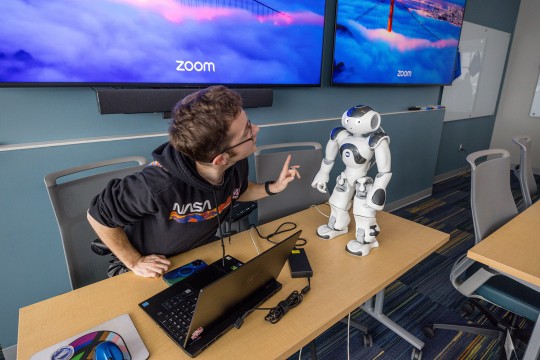First mathematical modeling Ph.D. student graduates from RIT
Nicole Rosato’s love of math drove her to complete multiple degrees
Nicole Rosato is the first student to graduate from RIT’s mathematical modeling Ph.D. program. Pictured, from right to left, are Associate Professor Nathan Cahill; Rosato; Professor Carlos Lousto; and Professor Mary Lynn Reed.
From her early days in school, Nicole Rosato realized that math was one of her favorite subjects. This past May, Rosato, who is from Paramus, N.J., became the first student to graduate from RIT’s new Ph.D. program in mathematical modeling. She also graduated from RIT’s master’s program in applied and computational mathematics.
What inspired you to study mathematical modeling?
My interest in mathematical modeling grew from my undergraduate thesis in combinatorics and graph theory. I took a year off and then decided to come to RIT to pursue my master’s degree in applied and computational math. I did my master’s with the Center for Computational Relativity and Gravitation studying binary black hole systems. The coursework and the professors were such a good fit for me and my style of learning that I decided to continue my Ph.D. at RIT studying under the same professors and my advisor, Professor Carlos Lousto.
What is the focus of your doctoral thesis?
My thesis focuses on studying black holes in orbit with each other, or binary black holes. I sought to find methods of improving numerical simulations of some of the most challenging-to-simulate kinds of these systems. There are currently three active detectors around the world by the LIGO and VIRGO collaborations that can detect gravitational waves emitted from binary black hole pairs which confirm Einstein’s Theory of Relativity. There are proposed advancements to these detectors, as well as a space-based detector proposed to launch in the 2030s, that will be able to detect more computationally difficult-to-simulate binaries. This means that we need more of these systems numerically simulated in time to compare with detector output. This is where I come in.
How does it feel to be the first person to graduate from the mathematical modeling Ph.D. program?
I am excited to be part of the first cohort for this program and I am looking forward to my classmates graduating, as well. I enjoyed being a trailblazer, but it is a big responsibility to be part of a brand new program. We have an obligation to set a standard for subsequent batches of students to look up to. I knew I wanted to be a part of the first cohort and that RIT would be a good fit from my overwhelmingly positive experience during my master’s studies.
How has this program helped cater to your aspirations?
The courses I enrolled in, along with the research I did, gave me a great foundation for my career. It also gave me all the skills I would need to be successful in the field, with core courses like mathematical programming, data science, and mathematical modeling. I am thrilled to say that I found a career that I absolutely love which allows me to make the best use of the skills I learned and have found a passion for during my doctoral studies.
What does the future hold?
I will continue to live in Rochester and work for Rochester Gas & Electric as a data engineer in their new Operational Performance group. It is a huge departure from my thesis work on black holes, but it employs many similar mathematical techniques. I truly enjoy what I do there.






